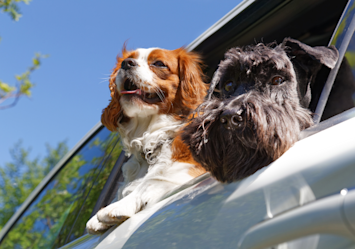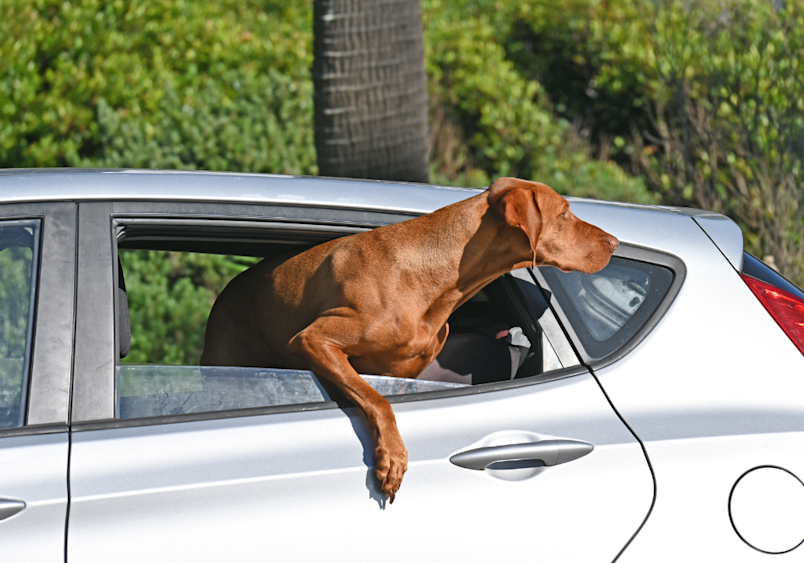
There are few things that can make you smile at the end of a long day, but driving home from work and passing a car with a dog’s head hanging out the window is one of them. The sheer joy on their face is enough to lighten nearly any mood. But it also may make you wonder: why do dogs stick their heads out the window? Do dogs love feeling the wind in their hair? Or is it something else? Also, is it safe? We’ll get into that and more.
Dogs Like Sticking Their Heads Out the Window for the Sensory Experience
Smell seems to a be a dog’s main sense when it comes to gathering information about their environment. While you may be able to smell spaghetti cooking for dinner, your dog can likely tell what individual ingredients are used and how long it’s been cooking.
Now, don’t get me wrong, your car has plenty of unique and exciting smells that your dog will likely be interested in, but when compared to the smells available in the great outdoors, there’s no contest. So why do dogs like to stick their head out the window? It’s the ultimate smell smorgasbord!
When you couple that with the warm sunshine and the refreshing wind, sticking their head out the window can be a very enlivening treat.
Dogs Find the Joy of Discovery with Their Heads Out the Window
You’ve no doubt seen your dog poking around your yard on their own. Though cats get most of the recognition, curiosity is actually a main driver for dogs as well. Not only do dogs seek out new and unique things, they also like to seek out enjoyable experiences.
Why do dogs like putting their heads out of car windows? The combination of new sights, smells, and the feeling of the wind creates pure joy! It allows them a closer look, smell, and feel of a greater part of the world and may even help reduce anxiety symptoms in dogs by helping them feel more in control.
The Risks of your Dog Sticking Thier Head Out of the Window
Though it may make your dog overly exuberant, sticking their head out the window does come with some risks. First of all, there’s the risk that they’ll get hit by something. Flying debris or even insects can cause ear and eye injuries on impact, especially at high speeds.
You also have the risk of your dog jumping or falling out of your car. As a vet, I’ve seen my fair share of fractured femurs from dogs that jumped out of the car trying to chase an animal or fell out barking at a passing car. Broken legs are bad enough, but these dogs were actually lucky considering a fall like this can be fatal.
We understand that you don’t want to quell your dog’s curiosity or keep them from inhaling as many tantalizing scents as possible, but letting them stick their head out the window can be a risky business. Instead, consider just cracking the window to allow some wind and scents in without them being able to fully put their head out of the car window.
You may also fit your car window with a screen or net that will keep your dog in while also letting in the outside air. For breeds like Golden Retriever, who love sticking their heads out car windows, a safety harness or seatbelt is essential. This keeps them safely tethered, preventing falls and ensuring a safe and enjoyable dog car window experience.

The Importance of Insurance for Dogs and Car Windows
We've explored why dogs like to stick their head out the window: the exciting smells, the rush of air, the visual stimulation. It's a sensory feast for our canine companions! But this beloved experience also presents potential dangers, and that's where responsible pet ownership – including having pet insurance – becomes crucial.
One of the most common questions is, "Why do dogs stick their heads out of car windows?" The answer, as we've discussed, is their natural curiosity and love of sensory input. However, this very enthusiasm can put them at risk. Projectiles, debris, and even low-hanging branches can cause serious injury. And, in a worst-case scenario, a sudden stop or accident could lead to a dog falling or jumping out of the window.
So, why do dogs like sticking their head out the window if it's so risky? It's because they don't fully understand the dangers. That's where we come in. As pet owners, it's our responsibility to ensure their safety and be prepared for the unexpected.
This preparation goes beyond simply using a harness or a carrier; it also means having a financial safety net in place should an accident occur.
That's why having a dog health insurance is such a vital part of responsible pet ownership, especially when it comes to potential car-related incidents. Even with the best precautions, unforeseen events can happen. A sudden swerve, a distracted driver, or a simple misjudgment can lead to an accident. And if your dog is injured while enjoying the view from the car window, the cost of veterinary care can be substantial.
For example, if your dog catches the scent of a squirrel while enjoying the breeze from the open car window and jumps out, the fall could result in anything from a sprain to a more serious injury like a broken leg. Treatment for a broken leg could involve X-rays, casting or surgery, pain medication, and follow-up visits. The cost? Potentially $1,000, $2,000, or even upwards of $3,000 depending on the severity. These unexpected expenses can put a significant strain on your budget.
Pet insurance can help alleviate that financial burden, allowing you to focus on your dog's recovery rather than worrying about how to pay the bills. Imagine the peace of mind knowing that if your dog is injured – whether it's a minor scrape from road debris or something more serious – you have the financial resources to provide them with the best possible care and get them back to putting their head out of the car window.
So, Why Do Dogs Stick Their Head Out of the Car Window?
You can likely picture a dog’s goofy grin and flapping ears and lips as they zoom down the road, head hanging out the car window. They are living life to the fullest, taking in every tantalizing scent, sight, and sound. Though you don’t want to take that away from them, there are safer ways to let your dog enjoy the experience. Using a seat belt, safety harness, or window covering can still allow your dog to indulge without the risk.
Ultimately, understanding why dogs love putting their head out of car windows allows us to appreciate their joy while prioritizing their safety. By taking precautions and being mindful of the potential dangers, we can ensure that their car rides are filled with happy memories, not heartbreak. After all, the best car rides are the ones where everyone arrives safe and sound, ready for the next adventure.